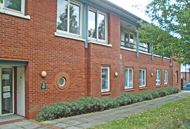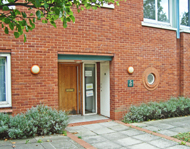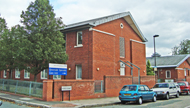Mental handicap
Hospitals for the mentally handicapped usually employed a proportion of their higher grade patients in occupations useful to the institution - domestic cleaning, launderring and gardening. However, a children's hospital such as the Fountain Hospital had no such labour available and it became the custom to transfer adult 'working' patients there from other institutions. Eighty such patients would be accommodated at one time at the Fountain Hospital itself but, around 1927, a new annexe, the South Side Home, was opened by the LCC as a hostel for these workers.
Essentially an enlarged house, South Side Home had 80 beds. The residents - all female - were classified as unsuitable for licence to a job in the community, but possibly suitable for work at the Fountain Hospital. As the referring institutions kept their best workers for themselves, the transferred patients were seldom of a high standard. Consequently a large proportion of the Fountain Hospital 'workers' were incompetent or emotionally disturbed (nearly half were returned in due course to their original hospitals). Workers received a small amount of pocket money per week.
During WW2 the Home was closed and the patients evacuated.
In 1948 the Home joined the NHS as part of the Fountain Hospital Group. The building had been untenanted up to this time as it was in a bad state of repair. It was rewired, fitted with fire alarms, re-plumbed and redecorated and, in 1950, female patients were again sent from the Fountain Hospital to live there.
The ground floor contained the dining and sitting rooms, newly re-equipped with chairs and carpets, a wireless and some books. The first floor contained the dormitory rooms for the residents, who slept on low divan beds.
On the top floor were the bedrooms for the resident staff - a Sister-in-charge, a deputy Sister, one night nurse and two cooks (one full-time and one part-time).
The young women were taught how to behave in nice surroundings, so that when they went out to service on licence they would know how to behave and how to help. Classes were held in basic education, cookery, dancing and keep-fit. Swimming sessions were held at the local baths.
In the 1950s some of the women were employed locally, for example, in the gas mantle factory, or in private homes as domestic servants, but they continued to live in South Side Home. The rest worked in the wards and laundry of the Fountain Hospital. Hospital jobs were more popular as the patients were used to institutional life and could get more company and better pay. As resident hospital domestics they earned £4 18d 6d (£4.92) a week, less tax, superannuation and a charge of 33 shillings (£1.65) for board and lodgings.
In 1959 the Fountain Group Hospital Management Committee merged with that of Queen Mary's Hospital in Carshalton, to become the Fountain and Carshalton Group.
In 1962 an Industrial Unit opened in a pre-fabricated building in the grounds. Patients worked in the Unit on screwdriver assembly, coat-hanger covering, and counting and packlng cable markers. The Home was redecorated again and the 'family group' system adopted, following the success of the scheme at Brooklands.In 1963 the Fountain Hospital closed and its remaining patients were transferred to the newly refurbished St Ebba's Hospital in Epsom or Queen Mary's Hospital, Carshalton.
By the end of the 1960s some 60 residents of the South Side Home were deemed mentally handicapped enough to be unlikely to become fully independent. However, 20 of the beds and (20 at The Turret) were occupied by patients whom it was hoped would be rehabilitated completely. One of the first steps to rehabitation was to provide them with possessions and a locker to keep them in, clothes of their own and money to buy them with, and stimulating work with adequate financial rewards. The Industrial Unit employed 30 girls from the South Side Home and The Turret, together with a number of daily patients (male and female) on contract work, under the supervision of two instructors. The workers had a day off each week when they could go out on their own or with a fellow resident (but no nurse or escort) and exercise initiative, broadening their experiences by taking buses, visiting the shops and going to the cinema.
During the NHS reorganisation in 1974 the Home came under the control of the St Helier and Queen Mary's Hospital District, part of the Merton, Sutton and Wandsworth Area Health Authority. As it was outside the geographical area covered by the District, it was managed on an extra-territorial basis.
It closed in 1987, when it had 82 beds.
Present status (September 2009)
South Side Home has been demolished and the site is now occupied by the Greenvale Nursing Home, Voss Court, a purpose-built 30-bedded unit providing 24-hour care for adults over the age of 65 with mental health needs. The nursing home is operated by the South London and Maudsley NHS Foundation Trust (SLAM).


The Greenvale Nursing Home as seen from Streatham Common, once the site of Nos. 4 and 5.

The entrance to 'The Office Suite' at No. 5 Streatham Common, presumably the administrative offices of SLAM.


The Voss Court frontage of the Greenvale Nursing Home (left) and its main entrance in Voss Court (right).
A small group of patients came from large families, with 12 or even up to 18 children. In the days before Family Allowances, such large families implied poverty and overcrowding, and the lack of supervision and early training may have been a factor in the mental immaturity and intellectual subnormality of these patients.
Inadequate opportunities for special education and the stultifying effect of many years in an institution meant that most were illiterate, although some later learned to read and write on their own, or attended LCC evening classes held at the South Side Home.
Hilliard LT 1954 Resettling mental defectives. British Medical Journal 1 (4875), 1372-1374.
http://hansard.millbanksystems.com
Return to home page